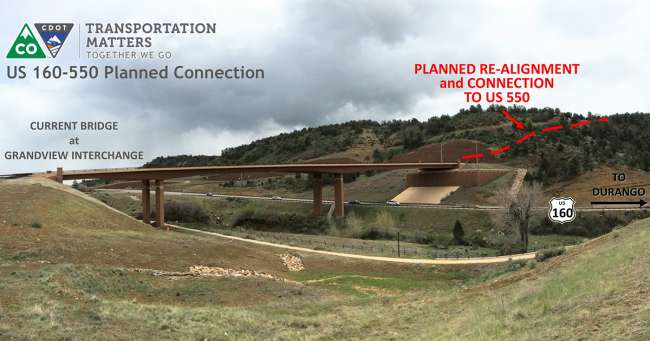Staff Reporter
DOT Grant Will Ease Truck Climbing, Congestion in Colorado

A new truck climbing lane and automated anti-icing systems are among the projects a $12 million federal grant will support in La Plata County, Colo., an area that draws thousands of trucks each year.
The U.S. Department of Transportation on Aug. 2 proposed the funding for the southwestern Colorado county, which would use the grant to construct a 1.7-mile alignment of U.S. Route 550, connecting with U.S. Route 160 at the Grandview Interchange.
According to the Colorado Department of Transportation’s Freight Authority Office, approximately 900 commercial trucks drive through La Plata County and Durango every day, using U.S. 550 and U.S. 160. Those roadways currently connect at an intersection about a mile southwest of the Grandview Interchange, which lies within the San Juan Mountains, about 17 miles north of Colorado’s border with New Mexico.
In addition to the climbing lane and anti-icing systems, the new alignment will include wider shoulders and flatter grades.

Fulton
The climbing lane will ease travel for trucks navigating the steep gradient of the connection between U.S. routes 550 and 160, according to Colorado Motor Carriers Association President Greg Fulton.
Mike McVaugh, regional transportation director of CDOT, said the “virgin alignment” will make the narrow two-lane highway, which climbs at a 6% grade for more than a mile, straighter and flatter.
“This is clearly going to facilitate some traffic in that corridor,” Fulton said. “The climbing lane has been something a lot of us had hoped would happen for some time.”
U.S. routes 550 and 160 are instrumental in moving freight across the state, according to McVaugh, citing industrial supplies to service natural gas production and agriculture.
“The interstates tend to serve the more heavily congested front range of Colorado, but when you start looking at our energy corridor and where agriculture is in Colorado, it’s these rural highways that are taking care of the freight industry going in and out of those areas,” he said.
Southwest Colorado attracts 1.2 million tourists a year, according to the Durango Area Tourism Office.
Jeff Digby, president of Voyager Express, a trucking company based in Denver, said that ski traffic is the greatest cause of congestion and gets worse every year.
McVaugh said there is a span of about 5 miles where U.S. 550 and U.S. 160 come together. On an average day, 35,000 vehicles travel on this corridor where the routes are combined, according to the state’s Freight Authority Office. However, during the summer, this segment sees 40,000 to 50,000 vehicles a day.
McVaugh said the climbing lane will allow slower-moving trucks to operate at their own speed and not feel pressured by drivers in smaller, faster vehicles.
The proposed grant will improve safety measures, Fulton said. The project will include anti-icing systems on roundabouts and two bridges near the interchange. The automated systems spray an anti-freeze solution on the roadways.
“It’s a north-facing slope. It ices up very easily,” McVaugh said. ‘You don’t have to de-ice the entire road; by having the bridges with de-icing liquid on them, the vehicles tend to track it onto other portions of the roadway.”
La Plata County’s funding is the largest of 10 grants awarded through the Fostering Advancements in Shipping and Transportation for the Long-term Achievement of National Efficiencies program. The FASTLANE grants, which apportioned $78.88 million to recipients, were authorized by the Fixing America’s Surface Transportation Act of 2015, which aims to provide long-term funding for infrastructure projects.
Digby said the grant is important because it addresses the needs of U.S. routes, rather than interstates.
“It’s critical, and sometimes it’s pushed to the back burner,” Digby said. “A lot of state roads are kind of the black sheep.”
Interstates often receive the most money because population drives funding.
McVaugh said Colorado’s last federal funding package, a Transportation Investment Generating Economic Recovery grant for $15 million, was issued in 2016.




